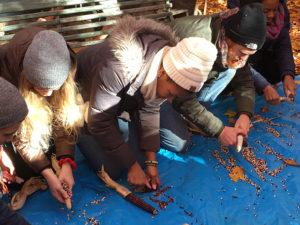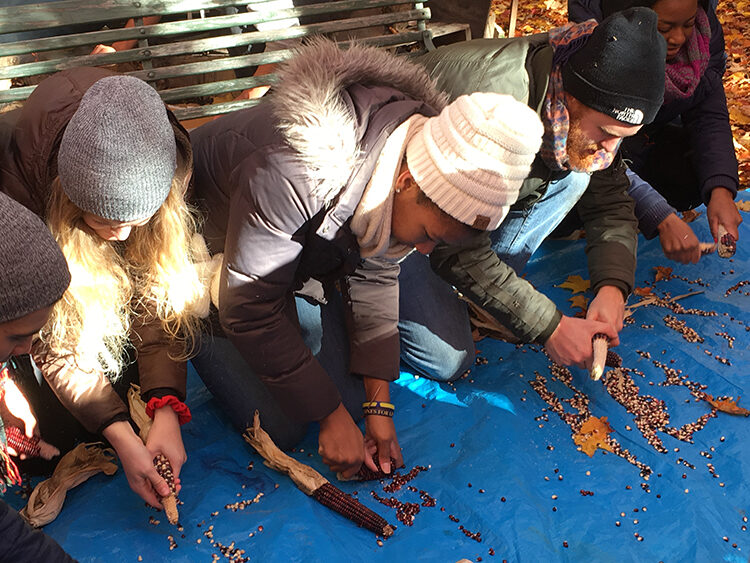
Students learn the most efficient ways remove kernels from the cob.
What is an Indian?
Students in the course Archives and Oral Histories thought this must be a loaded question when they were asked to write an essay on it the first time. Surely Indian isn’t the right word, several wrote, as they had been taught growing up that the politically correct term is Native American.
A couple of students said it was the name for people of India, and they blamed Christopher Columbus for the confusion because he used it to describe the native people he found when he thought he had landed in the east.
Others admitted they didn’t really know. A “foggy fairy tale,” one suggested. For others the name invoked images from popular culture: cowboys and Indians, war paint and feathered headdresses, the natives in the story “Peter Pan,” and the controversial Pocahontas, portrayed in an animated movie released around the time they were born.
Nearly all were sure they never had encountered an Indian in their lives.
“Their first writings were academic. You could tell they were well researched,” said Cecil E. Pavlat, Sr., Sault Ste. Marie Chippewa Tribe community member and retired leader, who with others from the Upper Peninsula tribe helped U-M faculty create an immersive experience for the students. The hope was that giving them somewhat unprecedented access to Anishinaabe rituals, customs and celebrations would help students answer the Indian question a little differently in two writings that would follow. (Anishinaabe refers to the Ojibwe, Odawa and Potawatomi people of Canada and the United States.)
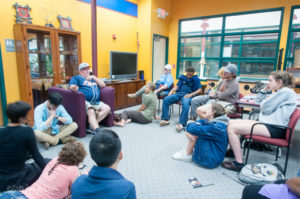
Through the course Archives and Oral Histories, U-M students learn firsthand the history and traditions of the Sault Ste. Marie Chippewa Tribe. Here Tribal Elder Cecil Pavlat shares stories with the students during a visit to the Tribal Learning Center. Photo by John Diehl, U-M.
Immersion and engagement
“This course is very engaged learning. I think that it’s one of the best ways to work with students in terms of helping them understand how their studies can interface with the rest of their lives,” said Anita Gonzalez, professor of theatre and drama.
The first part of the course immersed students in the culture of Native Americans, and the second part asked them to take what they learned from archives and ethnographic research and turn it into a performance piece.
The idea for a course that would allow students to learn about the Anishinabek living in Michigan came to Gonzalez after she went on the annual U-M Road Scholars tour.
Organized by the Office of the Vice President for Government Relations, the trip takes faculty on a five-day tour throughout Michigan in spring to expose them to the state’s economy, government and politics, culture, educational systems, health and social issues, history, and geography.
“When we came up to the Upper Peninsula, I fell in love with it,” said Gonzalez, who was surprised to learn there was not a strong relationship between the university and the tribe in the U.P.
Gonzalez approached Road Scholars organizer Dana Sitzler, associate director in OVPGR, about co-writing a Third Century Initiative grant to offer a course that would strengthen that connection. U-M has committed $25 million to teaching projects that transform the way students learn.
Sitzler knew the only way it could work was if tribal leaders were on board, so she took the idea to Pavlat and Jacqueline Minton. Both have helped with the Michigan Road Scholars program and were happy to participate in a project that would increase understanding about native people living in Michigan. Minton, cultural buildings coordinator for the tribe, manages the Mary Murray Cultural Camp on Sugar Island, across from Sault Ste. Marie. She regularly organizes events to help students in the tribe better understand their culture. Pavlat, who retired from the tribe’s cultural department, continues to teach language classes.
The team arranged meetings in Ann Arbor and on Sugar Island, culminating in a four-day immersive experience that allowed students to learn a number of traditions firsthand.
Corn teachings
Long a staple of the Native American diet, corn is considered one of the tribe’s sacred foods, along with strawberries and meat. Even today, members carry out the long process of drying the ears, removing kernels from the husk, boiling them with hardwood ash, removing the hulls, rinsing off the ash, and drying them again before making dishes like hominy corn soup.
Paula Modafferi, a dance major, couldn’t wrap her brain around the lengthy process at first when considering how easily available food is today.
“You save the corn over a year before you can make it edible,” she said, explaining that even after that lengthy drying period, preparation of the corn for consumption stretched out over several days.
Elder George Martin helped the students understand the importance of the tradition, sharing the story of how native people came to have corn. Legend has it that a young man asked the Chief Sky Spirit if there could be some food to feed his people without them having to hunt every day. The lengthy story involves the young man wrestling with a being that would essentially die, be buried and give rise to the crop.
Even Martin’s explanation of how an ear of corn is constructed sounded spiritual.
“Each one of those silks goes to one of those kernels. It’s like an umbilical cord that keeps that one kernel alive,” he told them.
Spiritual traditions
Fire illuminated the canvas-covered lodge that had one large hole in the ceiling to release smoke and lift prayers. As everyone waited quietly, reverently, for all to be assembled, the only steady sounds were the crackling fire and large heavy drops of melting snow landing on leaves that had barely made it to the ground.
Snow came early, even for the Upper Peninsula, as though planned for students who had never before seen the white stuff. Its presence allowed Pavlat to offer stories that could only be told after the first snowfall.
On U-M’s fall break weekend in mid-October there would be no sleeping in for these students, who got up early two mornings to experience this sacred ritual sunrise ceremony.
The signal the service had begun was Pavlat’s rhythmic drumming and his song of thanks and honor to the new day. It is at sunrise, he explained, that “all beings pause and reflect on what it is they have been provided.”
A spirit of thankfulness permeates most of the Anishinaabe sacred rituals. A few hours later the students participated in a sweat lodge, which is a time for expressions of thanks and prayers for others.
“I feel really grounded and open,” said Mia Massimino, interarts performance major. “Being in that altered physical state, and also altering your mental state in a different way, I thought was really beautiful and helpful.”
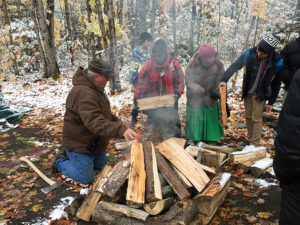
Students and faculty help build the fire that will heat rocks for the sweat lodge. Photo by Dana Sitzler, U-M.
In order to have full appreciation of the ceremonies, students were part of the preparation as well. They chopped wood to make the fires. Each chose a “grandfather” rock that would be heated by fire and then placed in a small pit in the center of the round, domed canvas-covered lodge to generate extreme heat. Students also gathered the cedar leaves that would line their path into the lodge and cover the bare ground where they would sit. Each step to prepare, including the precise placement of the leaves, had traditional significance.
“This morning Cecil was saying, at the sunrise ceremony, that he can’t give us everything because he doesn’t want to overwhelm us, but I feel like even what we’re getting, just the little bits, is just so filling. It feels good,” said Emma Bergman, also an interarts performance major. “It’s the kind of learning you don’t get in Ann Arbor.”
The storytellers
The histories of Native American tribes are rarely written down but are relayed orally from generation to generation. This includes tales about spiritual beings and the origins of some of the traditions, but also accounts of the every day lives of people.
“The Anishinaabe tend to share their personal stories and experiences, something we don’t see in academia. We sometimes forget that our personal stories are just as important as what we’re doing,” Sitzler said.
Students heard from Tribal Elder Mick Frechette, who left his beloved Sugar Island for the military and then employment in the auto industry. For years, living first in Germany and then Southeast Michigan, he longed to return to the island, and eventually did.
“I go up and down a road and see spots that remind me—certain smells when you are in the woods—that bring you back to your childhood, and it’s really beautiful,” he said.
Elder Leonard Kimewon told the students about the maple syrup he makes every spring just to share with friends—a process that is a lot of hard work. It wasn’t always so, he said, telling a story about how syrup once flowed freely from trees. But earlier people were “disrespecting the earth, eating it all and getting fat,” he explained, “so Creator made it only run in spring and only in the form of sap that had to be boiled to make syrup.”
Eighty-eight-year-old “Uncle” Basel Willis reminisced about days when money was not very plentiful but also not so important. Everything was bartered or darn cheap. “Three cents for a bushel of potatoes, I made 62 cents an hour working like a man. We respect people. We work hard and don’t have our hand out.”
Reclaiming what is lost
Although the stories do get passed down through the generations one thing that has not always been shared is the native language, Anishinaabemowin. It slowly has been disappearing, due in large part to the forced boarding school experience where native people were punished for using it. This made today’s elders reluctant to teach it to their children, so it rarely is used by modern generations. Tribal education leaders hope to change that, U-M students learned at another stop on their tour of important tribal locations.
“Mino-Giizhigad.” Mike Willis, Native American Studies department chair at Bay Mills Community College, told students in his language class that this means “nice day” in the Anishinaabemowin language.
“We take great pride in teaching our history, our way of life,” Willis told the U-M visitors prior to the class.
Bay Mills Community College, one of three of the state’s tribal colleges, along with other institutions, is working on a project to restore the language, offering intensive weekend courses as well as including it in college curriculum.
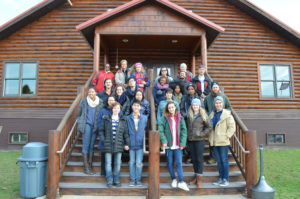
One of several field trips took the students to the Bay Mills Community College where they learned about efforts to revive the Anishinaabemowin language. Photo by Brenda Austin, photographer/reporter for the Tribal Newspaper.
Mixing of old and new
Just like Frechette’s stories about the contrasts of life in the auto industry and raising children who played hockey—very well, in fact—and then the culture back on the island, it is clear that being Anishinabek means holding tight to tradition while embracing contemporary culture.
While U-M students learned the traditional way to prepare corn for soup and light a fire using a flint and dried leaves, they devoured spaghetti, chicken pot pie, bagels and pancakes made on modern appliances and served with plates and utensils from the local Gordon Food Service.
The tribe’s regard for Mother Nature and all living creatures translated into talk about contemporary environmental concerns: fracking, over-use of resources and pollution.
“I’m not real proud of what we’re handing our children but I do believe we are teaching our children so that they can take care of it,” Minton said of the earth, and then challenging the U-M students. “You’re a vessel for all of this, you’re a voice for what’s going on out here in nature.”
Even the gravesites at Mission Hill Cemetery showed the contrast between tradition and contemporary culture. One grave was encircled with some 70 small field stones with first names crudely written on them, relatives presumably. A few feet away was a memorial with athletic caps and other paraphernalia bearing logos from teams like the Detroit Lions, Tigers and the Michigan Wolverines.
True to the storytelling, each grave offered a hint of the person buried there: photos, toy trucks, porcelain eagles, lighthouses, stain-glass butterflies, and dream catchers, are just a few of the keepsakes.
Gabrielle “Dani” Hayes couldn’t help but notice the difference in the very personalized resting places in this cemetery compared with those one might find in Southeast Michigan.
“People pay $10,000 to get a grave site and barely can decorate it with flowers,” she said. A few minutes later she saw a family name and wondered if there was any connection.
San Duanmu, professor of linguistics, offered an observation during a final talking circle that resonated with many of the students: “There are people who approach a different culture and say, ‘Look how different they are from us.’ Then there are people that enter a culture and say, ‘Oh, look how similar they are to us.’”
Revisiting the question
What is an Indian?
By the end of the weekend during moments of reflection at the camp and in essay No. 3 the answers came into focus.
During the talking circle, Zach Kolodziej, art and design, called the Sault tribe a “living, breathing culture” whose members have “strong teaching and traditions but are open to change.”
Samuel Hamashima, musical theatre, noted the attitude among the people that “every day is a gift.”
Bergman was thankful the weekend had provided a comfortable space “not to know” and to learn to answer the question.
Yifei Lu, an engineering major from China, had never experienced the forests and trees and wondered how different he might be if he had after witnessing the gentle spirit of those who call the woods their home.
“They’re starting to question some of the things that they learned through their academic careers and think about the people differently,” Sitzler said.
The final essays showed great growth as well.
Indians are “resilient, graceful, loving,” one student wrote. Others remarked on the native people’s sense of spirituality and belief in honoring the past.
One student described them as living lives “steeped in weighty traditions,” while claiming “the American struggle,” of having to make a living and deal with the same issues encountered by people outside of their tribes.
Each of the students wrote about an experience that changed them: made them think more about nature and be thankful for relationships and opportunities.
And that question about how PC the term Indian is finally was resolved. Several wrote that Pavlat told them it’s all about the intent of the user—as simple as that.

